Dundry Reservoir & Pumping Station (2016)
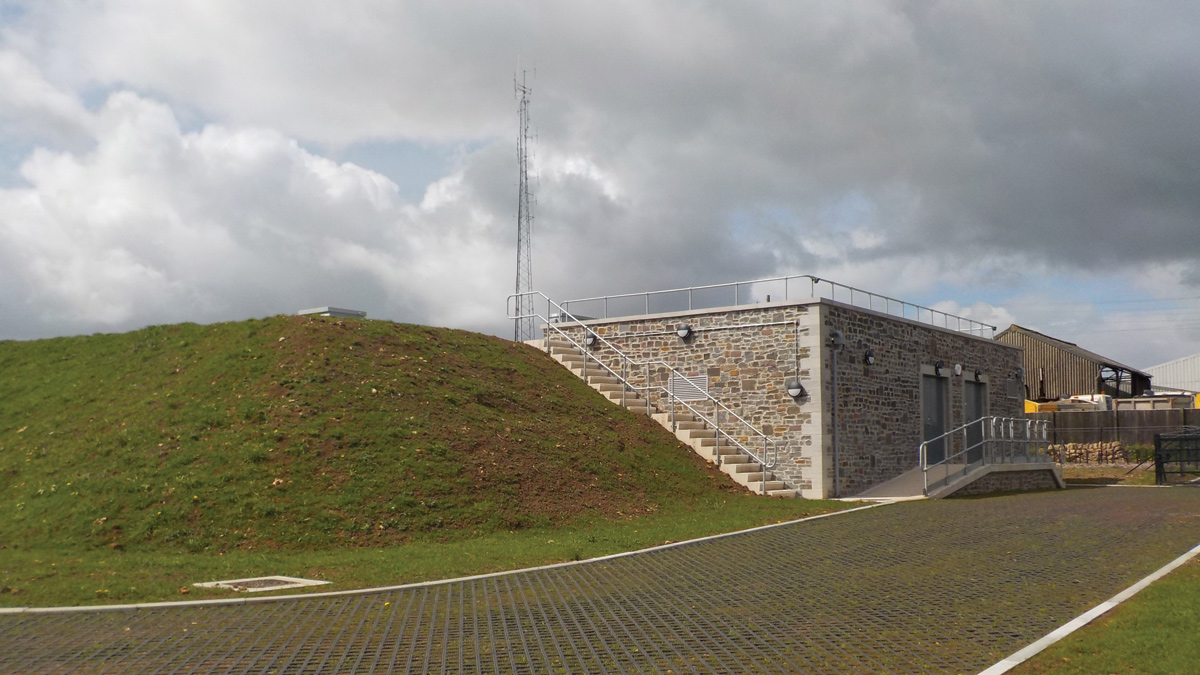
Dundry Reservoir and Pumping Station - Courtesy of Bristol Water
Dundry Reservoir and Pumping Station is located just 6 miles south of Bristol and provides a reliable supply of potable water to a population of circa 8000 located in the villages of Dundry, Highridge and Withywood. The original reservoir built in the 1950s did not have sufficient capacity for operational and emergency storage to meet future demand under ADPW conditions by 2035, so Bristol Water opted to construct a new reservoir and pumping station to the east of the original site. The new reservoir has an effective storage capacity of 1.1Ml and includes 200mm diameter inlet and outlet gravity pipework as well as a 100mm diameter pumped supply. The scheme also includes some off-site cross connection mains work and an additional 1km of reinforcement main.
Site and habitat
The new reservoir site covers an area of approximately 1 acre and is at a similar elevation to the original site, allowing existing hydraulic conditions to be maintained whilst minimising associated infrastructure works. An additional 1 acre of adjoining land was leased during the construction period for use as a site compound and contractor’s temporary working area.
Site investigation, comprising of trial pits, trenches and boreholes, established that the site was underlain by a sequence of strata comprising topsoil/superficial infill material, Inferior Oolite Group and Whitby Mudstone Formation. The investigation further identified that the limestone bedrock surface was variable across the site, including the footprint of the reservoir, with infilled fissures.
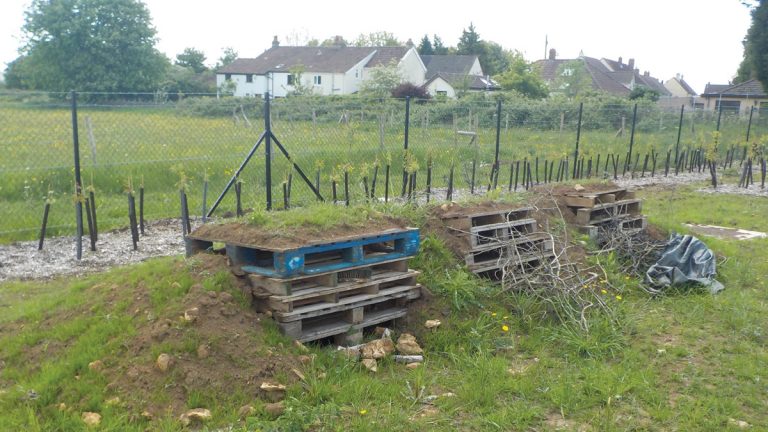
Bug hotels constructed using recycled pallets – Courtesy of Bristol Water
The ecological surveys identified that the habitats within the site were of low ecological importance and that the development would not cause any adverse ecological impact to the local area. There are three statutory nature conservation designation sites within 5km of the site and one non-statutory designated site within 3.5km of the site.
Notwithstanding the fact that the site was identified as having low ecological value, a key objective of the project was not only to protect but to enhance habitats. This resulted in us working closely with the Parish Council, contractor and local residents, as well as our own environmental management team, to include the following enhancements.
- The creation of bug hotels using recycled pallets.
- Site reinstatement to include a green hay transfer from a SSSI donor site providing a much improved and diverse meadow grassland.
- The relocation and incorporation of pignut plants; the primary habitat for the rare chimney sweeper moth.
- A significant native shrub and tree planting scheme.
With the above features, the biodiversity of the site will naturally increase over time resulting in a site with a much enhanced ecological value when compared to the original site. This also contributes to the improvement of the company’s Biodiversity Index, an innovative measure used to quantify, monitor and improve biodiversity.
An important consideration throughout the project was close stakeholder engagement and liaison with the local community, including regular attendance at Parish Council meetings. It has also been important to keep this engagement going following completion of the project recognising that the local residents are also customers and that this upgrade is part of the ongoing service Bristol Water provide.
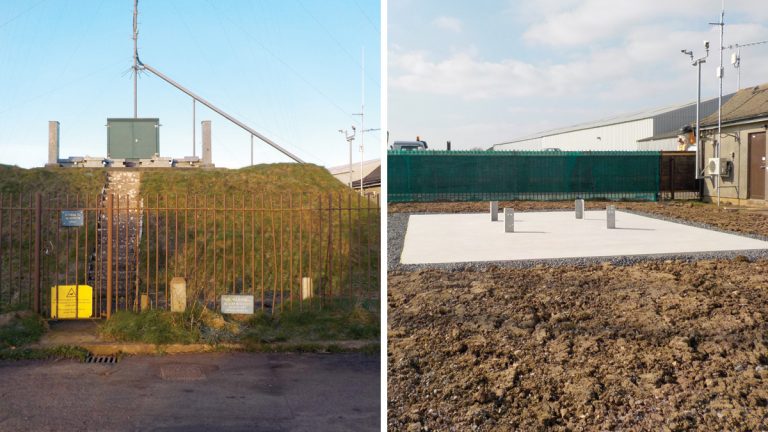
(left) Original Reservoir site prior to decommissioning and demolition and (right) original reservoir site following decommissioning and construction of the communication tower base slab (utilising one compartment of the old reservoir) – Courtesy of Bristol Water
Civil design
To minimise visual impact, the reservoir was designed with a grass covered roof and embankments together with a grass site access road constructed from an interlocking recycled polyethylene ground mat system. The use of natural pennant stone to exposed faces of the pumping station and valve chamber structure, together with a sympathetic landscaping and planting scheme, all added to minimise this impact.
Following the topographical site survey, a 3D ground model was produced using Key Terra Firma software allowing the optimum location and formation level of the reservoir to be determined providing a cut and fill balance that negated the need to import or dispose of any surplus excavated material. This further added to reducing the environmental impact of the project by minimising construction traffic during the works.
The reservoir itself is a twin compartment reinforced concrete structure, measuring approximately 25m by 16m on plan and 4.6m high partly buried below natural ground level by up to 2.4m. The valve chamber and pumping station structure abuts the reservoir with access provided at ground level.
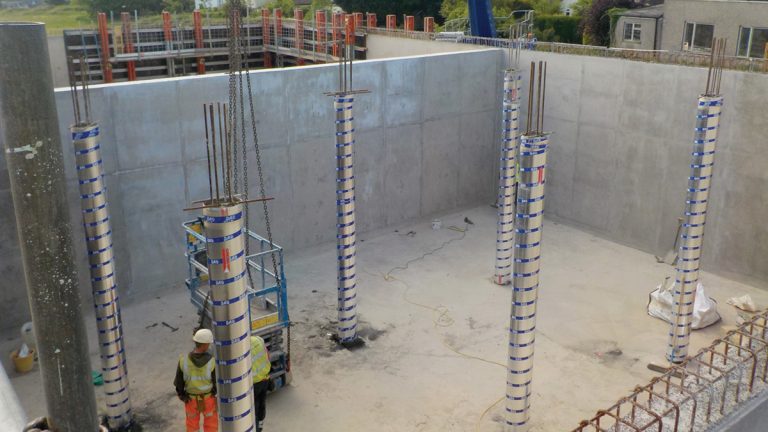
Column formwork utilising cardboard tube formers – Courtesy of Bristol Water
The roof of the reservoir was designed as a flat slab supported on short columns with an approximate symmetrical arrangement and propped cantilever perimeter walls. The central compartment wall was designed as a pure cantilever to avoid any direct roof connection and restraint.
At the reservoir and pumping station formation level, the strata varied between completely weathered granular material and weak, approaching medium, strong limestone with infilled fissure features. This resulted with a conservative presumed bearing value of 250 kN/m2 being adopted. To mitigate the risk of any significant differential movement, due to the fissures, the floor was designed as a flat slab to span at least a nominal distance of 3m and to cantilever at least a nominal distance of 1.5m.
The analysis and design of the structure was carried out primarily using CSC TEDDS software to BS8007 and EC2 Part 3 and checked in both test and maintenance conditions, i.e. with no backfill and reservoir full, and with backfill and reservoir empty.
To aid the construction programme, the design also catered for continuous construction and the use of disposable cardboard tube column formers. RC detailing and scheduling was carried out using MultiSuite Rebar software.
The roof to the reservoir has the added protection of a single ply membrane covered with a granular stone drainage media layer and geotextile, over which the topsoil layer was placed.
Sustainable on-site drainage solutions were adopted again minimising any off site infrastructure works and associated environmental impact.
M&E design
Recognising the relative close proximity of the site to residential properties, an ambient background noise survey was undertaken and a number of features incorporated in to the design in order to control noise breakout from the pumping station. This included orientating the pumping station and any openings within the structure such they faced away from the properties, the installation of extract fan silencers and acoustic louvres to air inlet positions.
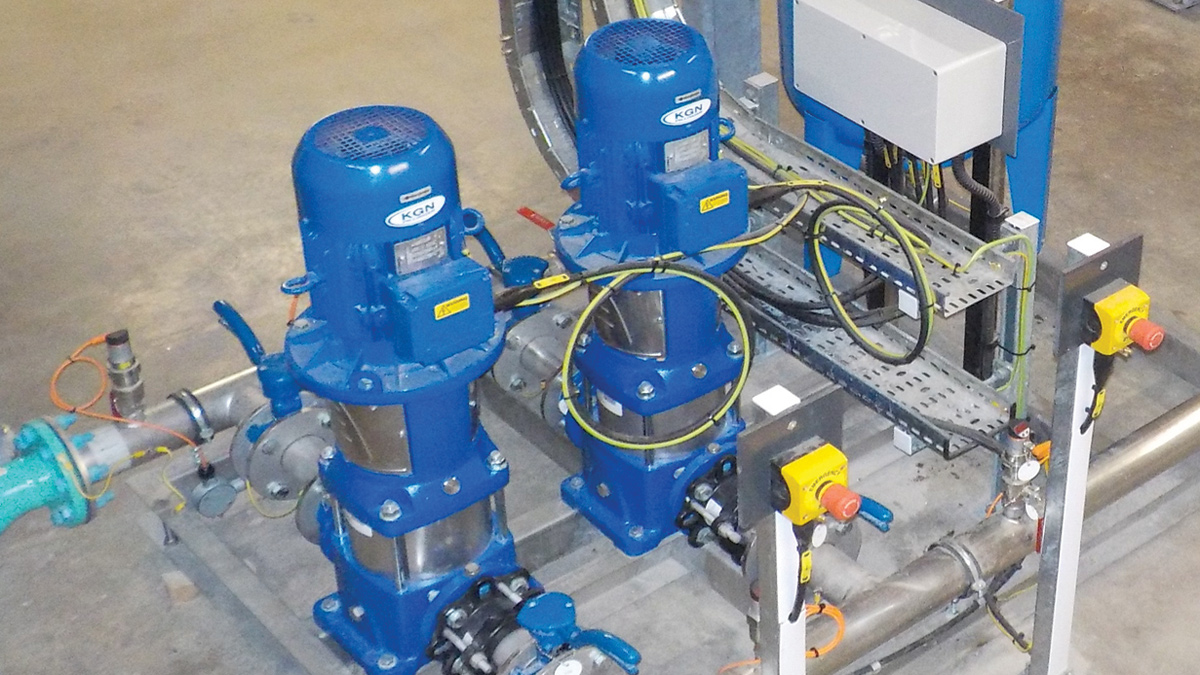
Skid mounted package pumpset – Courtesy of Bristol Water
The pumps were supplied by Pillinger in the form of a skid mounted package incorporating 2 (No.) Lowara single head pumps in a duty/standby configuration, together with a hydropneumatic vessel and associated manifold pipework and controls. The pumps were successfully factory acceptance tested (FAT) to the design duty of 9l/s at 30m head, achieving just under 90% motor efficiency.
In a similar manner to noise, external lighting was also given careful consideration during the design process to avoid any nuisance to local residents as well as unnecessary light pollution and environmental impact.
Procurement and construction
Following a prequalification and tendering process, the contract was awarded to contractor ACIEM Ltd based on full design information using IChemE Red Book Standard Form of Agreement. Materials (including pipework, access covers and kiosks) were procured directly by Bristol Water and free issued to the contractor. Construction took place over a 9 month period at a cost of ~£1m.
A particular innovation trialled during construction was the use of controlled permeability formwork (CPF) liners that were attached to a sample area of the formwork face. These are designed to remove excess air and water from the formwork/formwork interface during placement and initial concrete curing/setting. The potential benefit is a surface relatively free from imperfections, notably blow holes, and increased concrete durability. The trial was deemed successful and will be considered for use on future reservoir projects to minimise the need for concrete finishing works, as well as potentially allowing a reduced plywood shutter specification to be adopted.
The reservoir successfully passed both roof leakage and drop tests and the pumping station a 28 day pumping performance test.
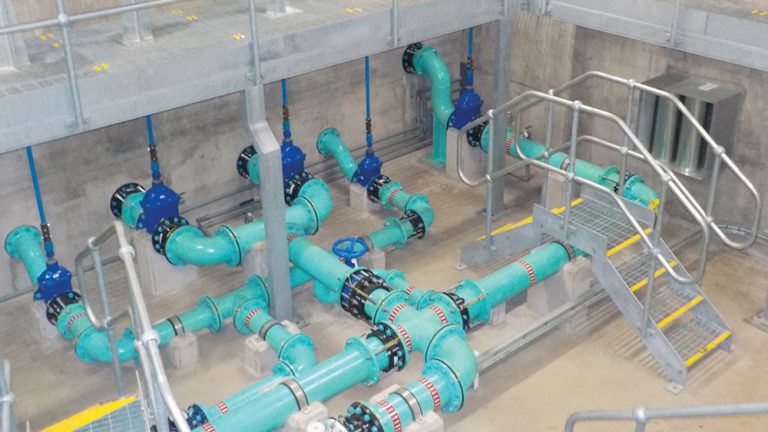
Valve house pipework – Courtesy of Bristol Water
Original reservoir & pumping station site decommissioning
The old reservoir site has now been decommissioned and partly demolished to allow the installation of a new communication mast. This will replace an old mast that was located on the roof of the old reservoir that could no longer be safely accessed for the purpose of undertaking inspection and maintenance works.
Decommissioning included some salvage of equipment, the isolation and capping of redundant mains and the demolition of the reservoir to ground level. For the new mast foundation, one compartment of the existing reservoir structure was utilised as a permanent back shutter. The old pumping station now houses a new standby generator, serving the new reservoir and pumping station as well as the new communications mast site.
Post construction review/lessons learned
Following internal handover of the project to the company’s O&M team, a post construction review was held with all project stakeholders to review performance of the project and to identify any lessons to be learned. This concluded that the project was an overall success meeting the key objectives of the original project plan. A key contributing factor to the success of the project was deemed to be due to the close liaison and engagement with all stakeholders at every stage of the project.
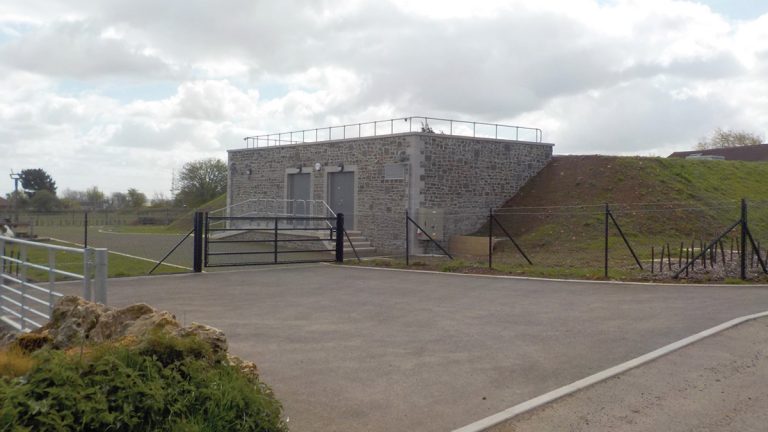
Dundry Reservoir and Pumping Station – Courtesy of Bristol Water
The scheme was designed and project managed in house by Bristol Water’s Network Projects Team and constructed by contractor ACIEM Ltd. The reservoir and pumping station has been in operational service since October 2015



